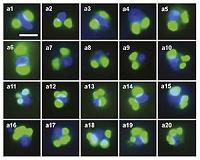| . |  |
. |
London UK (SPX) Mar 08, 2011 New research, funded by the Biotechnology and Biological Sciences Research Council (BBSRC) has shown that nematode worms have to trade-off resistance to different diseases, gaining resistance to one microbe at the expense of becoming more vulnerable to another. This finding, published in PLoS ONE (2 March 2011), reveals that the worms, called C. elegans, have a much more complex immune system than was previously thought and shows how important such trade-offs are across the animal kingdom. Dr Robin May from the University of Birmingham's School of Biosciences who worked on the study explains: "This finding was a real surprise. These worms have quite a simple immune system, so when we deleted a gene which we already knew provided resistance to a type of fungus; we were amazed to find that the worms became more resistant to Salmonella bacteria. It seems that evolving resistance to the fungus came at the cost of making the worms more vulnerable to other diseases. "Whilst scientists have seen this phenomenon, where there is a see-saw balance between immunity to different diseases, in more complex animals before, it has never been shown in anything as simple as a nematode worm. We think that this phenomenon evolved separately in C. elegans indicating that this trade off is important across the animal kingdom." An immune system costs an animal a lot of energy to maintain and carries the risk of inadvertently damaging the host, as in the case of allergies. Because of this, animals have to balance the costs and benefits of immunity, so putting more resources into fighting off bacteria might increase susceptibility to viruses for example, or vice versa. Dr May continues: "All animals live in a world of limited resources which means that evolution has to compromise. Being a successful animal means that evolution has struck the right balance. It seems in this instance it was important that these nematodes became resistant to fungi like Cryptococcus even if it cost them resistance to Salmonella." The gene that the researchers deleted, lys-7, normally produces something called a lysozyme which works in the immune system to attack invading microbes. Although most lysozymes fend off bacterial infections, this particular version seems to protect against infection by a type of fungus called Cryptococcus neoformans which is also a pathogen of humans causing infections in people with weakened immune systems like AIDS patients. Dr May continues: "We're not quite sure why losing this lysozyme makes the worms better equipped to fight off Salmonella. One possibility is that losing the gene gives other parts of immune system a boost, or perhaps Salmonella normally turns on its defence mechanisms in response to the presence of this lysozyme." Professor Douglas Kell, BBSRC Chief Executive said "Work in simple model organisms can provide us with insights into fundamental biology that apply across the natural world. This research is a great example. Understanding how the immune system works and how it has evolved in different animals will be important in dealing with a number challenges facing society, from chronic inflammation reducing people's quality of life in old age, to crop pests developing resistance to pesticides."
Share This Article With Planet Earth
Related Links Biotechnology and Biological Sciences Research Council Darwin Today At TerraDaily.com
 New Group Of Algae Discovered
New Group Of Algae DiscoveredMoffett Field CA (SPX) Mar 07, 2011 A team of biologists has discovered an entirely new group of algae living in a wide variety of marine and freshwater environments. This group of algae, which the researchers dubbed "rappemonads," have DNA that is distinctly different from that of other known algae. In fact, humans and mushrooms are more closely related to each other than rappemonads are to some other common algae (such as green ... read more |
|
| The content herein, unless otherwise known to be public domain, are Copyright 1995-2010 - SpaceDaily. AFP and UPI Wire Stories are copyright Agence France-Presse and United Press International. ESA Portal Reports are copyright European Space Agency. All NASA sourced material is public domain. Additional copyrights may apply in whole or part to other bona fide parties. Advertising does not imply endorsement,agreement or approval of any opinions, statements or information provided by SpaceDaily on any Web page published or hosted by SpaceDaily. Privacy Statement |